Thai Innovators Step Up to Fight the Pandemic
Thai Innovators Step Up to Fight the Pandemic
วันที่นำเข้าข้อมูล 25 ต.ค. 2564
วันที่ปรับปรุงข้อมูล 29 พ.ย. 2565
This article was originally published on Thailand NOW
Necessity is the mother of invention. Social distancing, face mask mandates, hygiene concerns, and other restrictions caused by the COVID-19 crisis have driven the advancement of medical technologies and consumer products.
A StartupBlink report shows that there are over 1,300 projects around the world dedicated to finding innovative COVID-19 solutions from the fields of diagnostics to life & business adaptations.
Thailand is no different. Amid such dire circumstances, Thai pioneers and researchers have continued to churn out an array of new innovations to address the struggles of the pandemic.
This article will explore innovative ideas and lifesaving technologies developed here in Thailand in the fight against COVID-19.
The case for innovation amid crisis
In lean times, certain kinds of research & development are the first thing to get axed from the budget, especially in the private sector. However, McKinsey research indicates that organizations that invest in innovation through crises outperform their peers in recovery.
Indeed, there are many reasons why Thailand would emerge stronger from the pandemic, from a strong consumer emphasis on financial discipline to broader adoption of cashless payment options.
Read More: The Dawn of Thailand’s e-Payment Era
Amid the myriad challenges posed by COVID-19, one silver lining may be that Thailand’s robust ecosystem of research centers, engineering labs, and tech incubators have united behind a common cause to focus their research and development, a major factor in crisis innovation.
In fact, The World Intellectual Property Organization’s (WIPO) 2021 edition of the Global Innovation Index (GII) report, “Tracking Innovation through the COVID-19 Crisis,” stated that Thailand’s performance has exceeded expectations.
To this end, the Thai government has issued THB2.8 billion (US$86.37 million) in funding for COVID-19-related research (🇹🇭), including for the development of vaccine candidates.
Thai innovations inspired by COVID-19
Many of these innovations, though inspired by the pandemic, will continue to find commercial applications far beyond the current crisis and contribute to Thailand’s emerging value-based economy.
Z-Touch
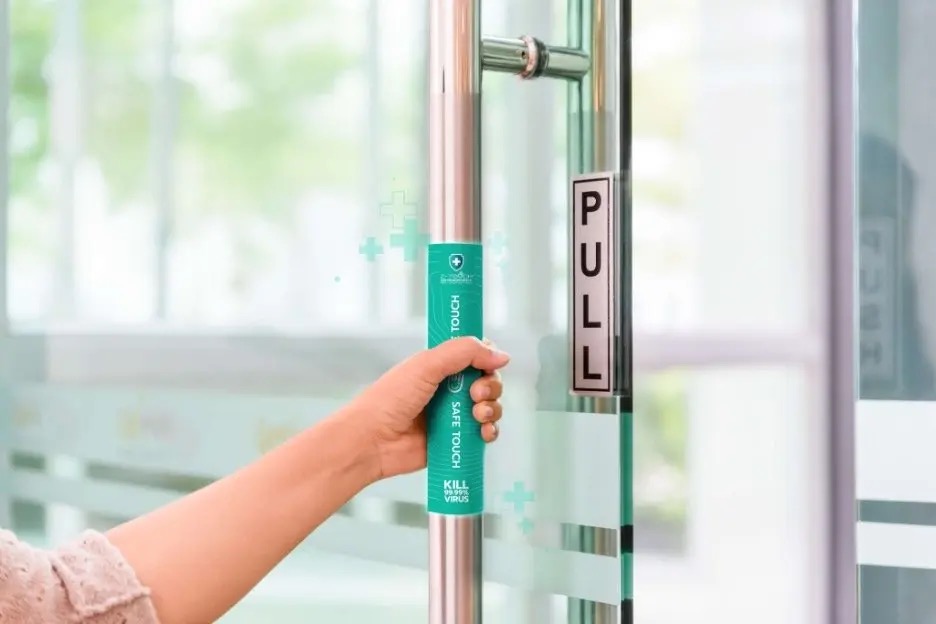
The Z-Touch pull door handle antimicrobial pad provides a safe area to hold on a high-touch surface. Source: Z-Touch.
At a time when touching an elevator button or door handle could lead to the transmission of a highly infectious disease, it’s become commonplace to see high-touch surfaces being disinfected and wiped down several times a day. This aspect of the pandemic has inspired Thai engineers to join hands with ACLIV, an anti-microbial solutions firm based in Seoul, South Korea, and develop Z-Touch (🇹🇭), a self-cleaning, anti-microbial protection pad.
The Z-Touch pad consists of three layers: the surface layer, the middle “Micro-Porous Layer” that draws microbes from the surface, and the deepest “Smart Nano Ion” layer, where the microbes can be chemically lysed or destroyed.
Z-Touch has been proven to eliminate as much as 99.9% of the coronavirus within five minutes. However, studies have shown that Z-Touch also works with H1N1 (which causes swine flu), bacteria, and fungi, making it an excellent tool for public venues such as hospitals and shopping malls. In fact, major establishments have already installed Z-Touch pads to protect visitors, including Suvarnabhumi Airport, Siriraj Hospital, and Novotel Phuket City Phokeethra.
Shield+ Protecting Spray
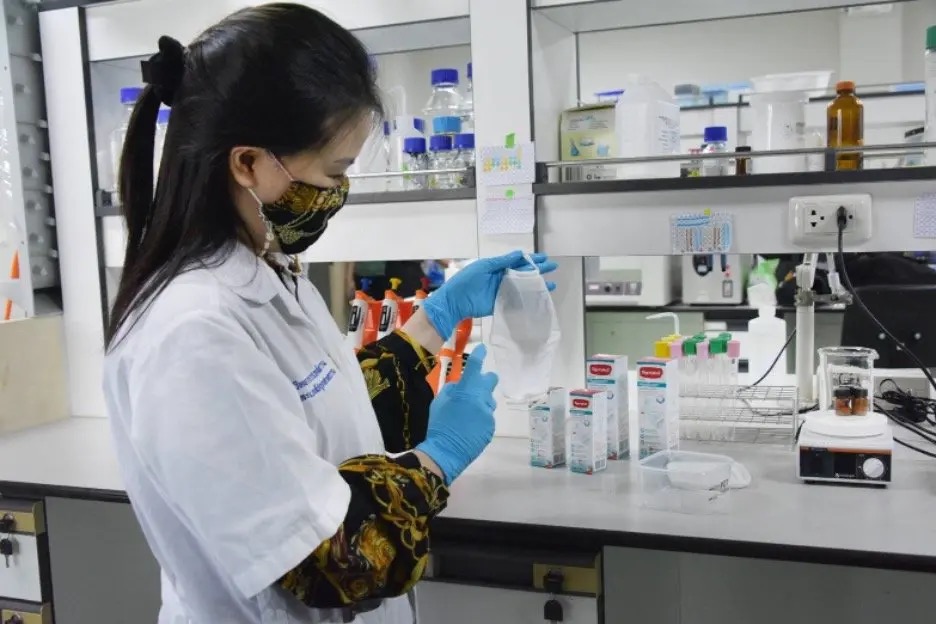
Chulalongkorn University’s Asst. Prof. Jittima Luckanagul demonstrating the Shield+ Protecting Spray on a cloth face mask. Source: Chulalongkorn University
Face masks may be vital when it comes to reducing disease transmission, but they’ve been a trade-off against environmental concerns, especially waste management and plastic pollution.
While cloth masks seem to be a more eco-friendly option, Col. Dr. Danabhand Phiboonbanakit (🇹🇭) of the Division of Infectious Diseases, Phramongkutklao Hospital (🇹🇭) has pointed out that cloth masks help prevent wearers from spreading the virus, not so much against it.
Chulalongkorn University (CU) has dedicated much of its ongoing research efforts to addressing the problems of the pandemic and has managed to solve this issue with their COVID-inspired innovation, Shield+ Protecting Spray.
Read More: Chula Innovations to Fight COVID-19
Developed by CU Innovation Hub (🇹🇭) in cooperation with the Faculty of Pharmaceutical Sciences, Shield+ Protecting Spray enhances the efficiency of cloth masks by filling in tiny gaps between the fibres with polymers, tightening the structure.
As a result, the sprayed masks are up to 83% more effective against 0.3-micron particles. Similarly, filtration rates for germs in saliva and airborne viruses—such as SARS-CoV-2, the virus that causes COVID-19—increase by 93% and 142%, respectively.
KNIN II: Mini Emergency Ventilator
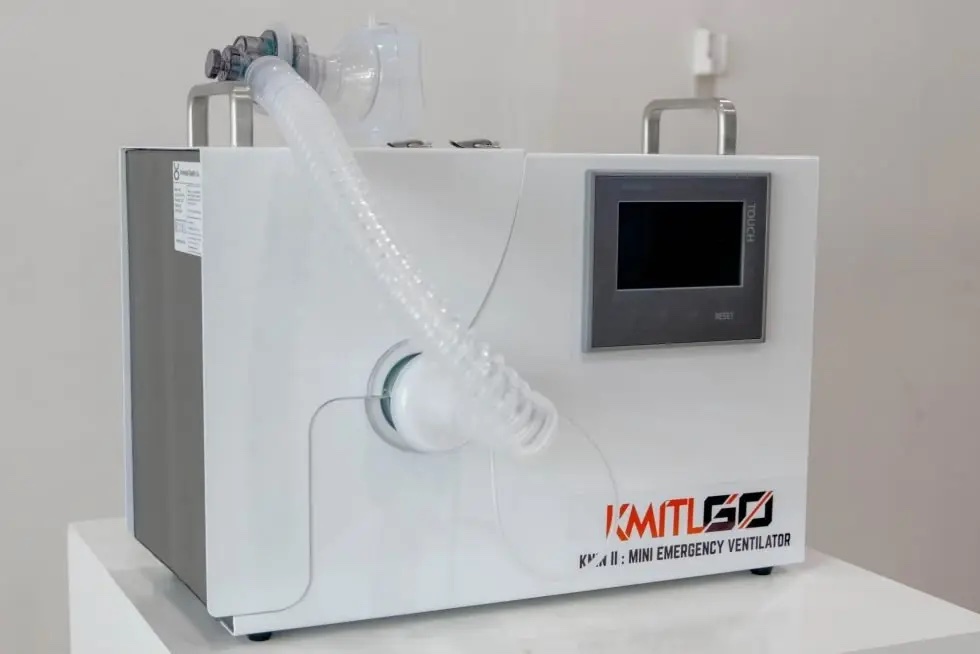
KNIN II is the latest version of the mini ventilator used to mitigate the need for traditional machines and in patient transport. Source: KMITL
The novel coronavirus infects the respiratory system and, in severe cases, causes pneumonia and compromises your ability to breathe independently. Consequently, ventilators are crucial for lifesaving medical intervention, which has led several countries to experience a shortage of this equipment.
To help mitigate the need for ventilators, King Mongkut’s Institute of Technology, Ladkrabang (KMITL) (🇹🇭) has successfully created the “KNIN II: Mini Emergency Ventilator.” As the name suggests, it is a small ventilator that mimics the mechanism of a bag valve mask.
Although very accessible and mobile, KNIN II is more suited to patient transports and emergency situations and cannot replace traditional machines.
Negative Pressure Mobile Beds
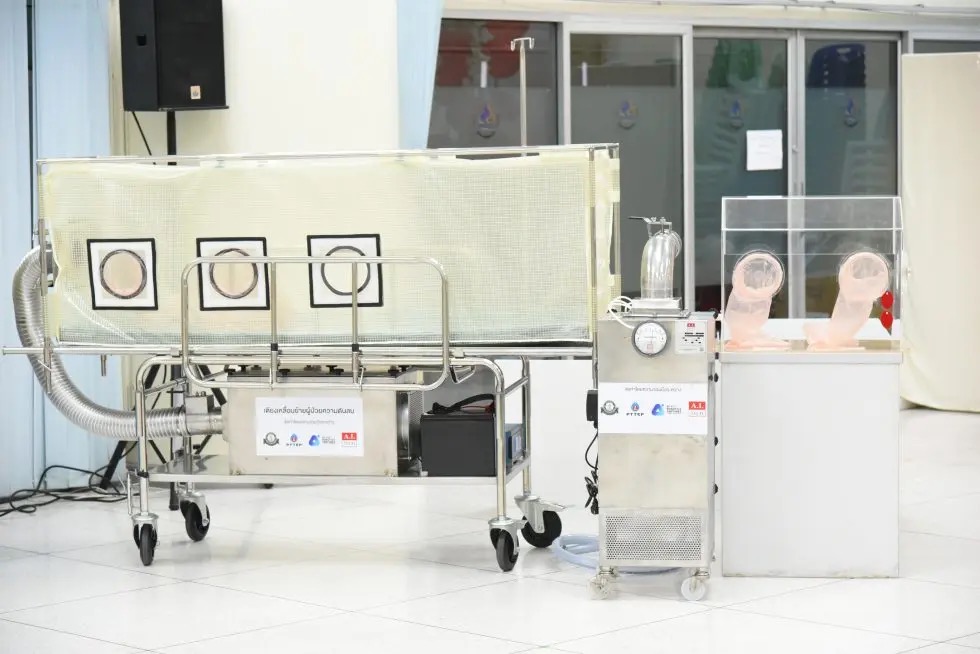
A prototype of the Negative Pressure Mobile Bed displayed at the Faculty of Medicine, Vajira Hospital, Navamindradhiraj University. Source: Vajira Hospital
As it is with any pandemic, the greatest risk of infection is to the medical workers who come into frequent contact with infected patients. To prevent hospitals from becoming ground zero for new outbreaks, it’s important to be able to effectively quarantine patients without hindering treatment.
The Faculty of Medicine Vajira Hospital, Navamindradhiraj University has created the Negative Pressure Patient Transfer Bed. By creating a capsule-like mobile bed using clear plastic sheets attached to a negative pressure generator, the lower pressure inside will prevent air from flowing out. Hence, the virus is contained within the sheets.
Vajira Hospital has since received assistance from Thai corporations and state enterprises, refining their prototype to make it more durable and practical and scaling production. Currently, 100 negative pressure mobile beds have been commissioned and are being distributed to over 90 hospitals across Thailand.
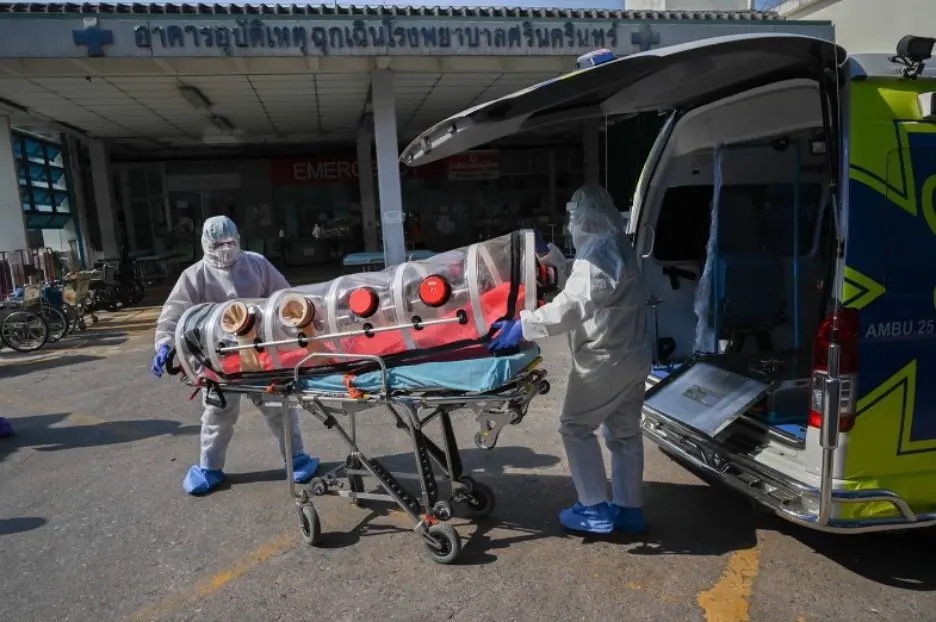
Medical personnel demonstrating Khon Kaen University’s negative patient transfer bed at Srinagarind Hospital, Khon Kaen. Source: Khon Kaen University
Similarly, the Faculty of Engineering, Khon Kaen University (🇹🇭) has rolled out a series of innovations, including what it calls a “Negative Patient Transfer Bed.” KKU’s Negative Patient Transfer Bed operates on the same principle and costs as little as THB24,000, a vast improvement over imports that can range between THB500,000 and THB1 million.
After the COVID-19 crisis has passed, negative pressure beds can be used for a range of other airborne infectious diseases, including measles, tuberculosis, and chickenpox. The ability to produce these beds domestically will also contribute tremendously to Thailand’s medical hub credentials and aspirations for medical equipment manufacturing.

Thai monks wearing cloth masks and face shields while accepting their daily alms. Source: Thavorn Rueang / Shutterstock.com
Since early 2020, Thailand and the rest of the world stepped into a different reality of masks, sanitizers, sickness, and isolation. Those most able to pivot and adapt to these circumstances are the ones who are most likely to succeed post-COVID-19.
Some of these adaptations have taken place already, with Thai people continuing to come together in online business meetings, yoga classes, school lessons, and even Wai Kru ceremonies, giving society ways to move forward.
Now more than ever, we are counting on our best and brightest to set their mind to the challenge, keep our public spaces safe, and protect our frontline medical workers. While many of these products will find commercial use after the pandemic and contribute to Thailand’s infrastructure and medical industry, the country’s true strength will continue to lie in its capacity to innovate.
About the Content Creator:
Natcha Jantararotai
A writer, translator, and avid reader, Natcha, or Lha, works in the field of digital diplomacy at a foreign government organisation. Aside from her interest in cross-culture communication, she is passionate about storytelling and how creativity can be used as a tool to inspire groundbreaking solutions. Her love for nature and the urge to support local communities play a crucial role in her writing pieces.
Home
ASEAN SUMMIT
ธุรกิจ | Business
ASEAN Connectivity
เอกสารเผยแพร่
- ปฏิญญาอาเซียนว่าด้วยสิทธิมนุษยชน (ASEAN Human Rights Declaration - AHRD)
- Guidelines on Accreditation of CSOs
- Guidelines on the Use of the ASEAN Flag
- Guidelines on the Use of the ASEAN Emblem
- Guidelines on the Accreditation of Entities Associated with ASEAN
- Guidelines on the Use of the Name "ASEAN"
- กฎบัตรอาเซียน (ASEAN Charter)